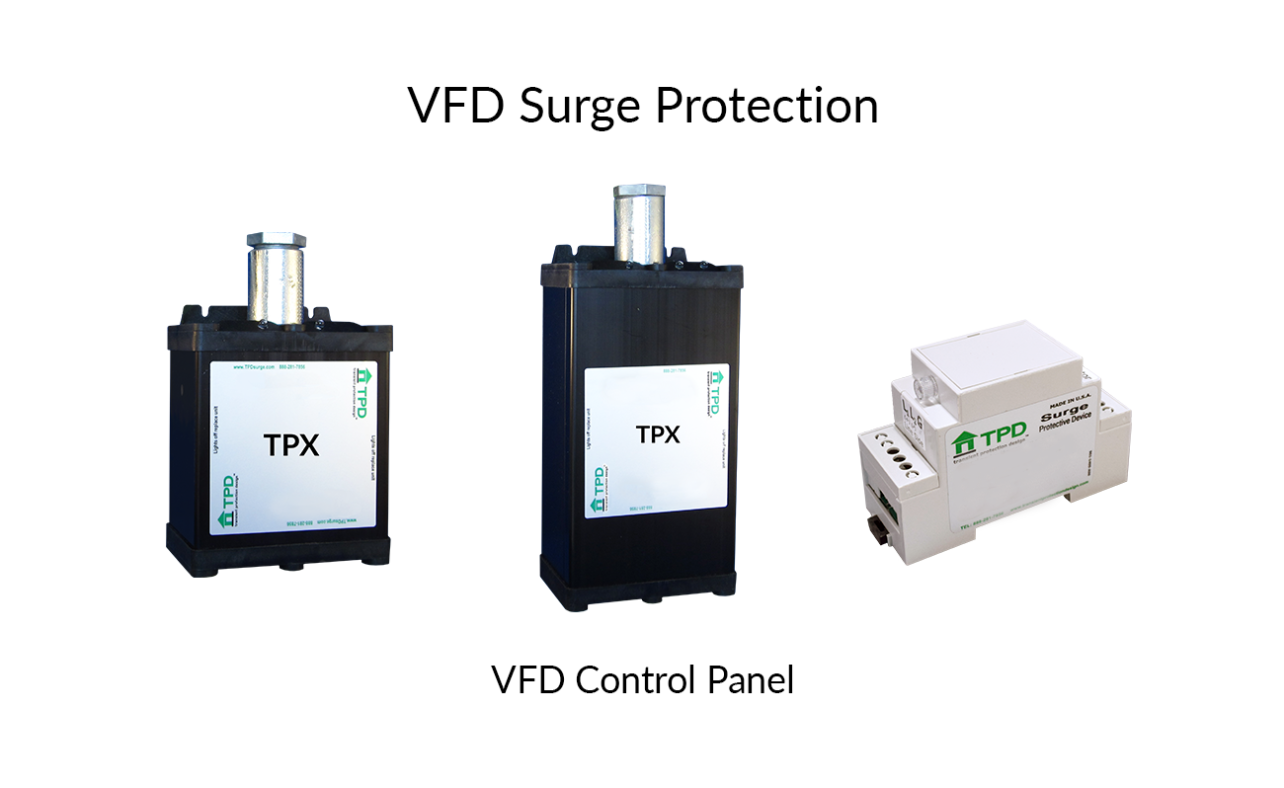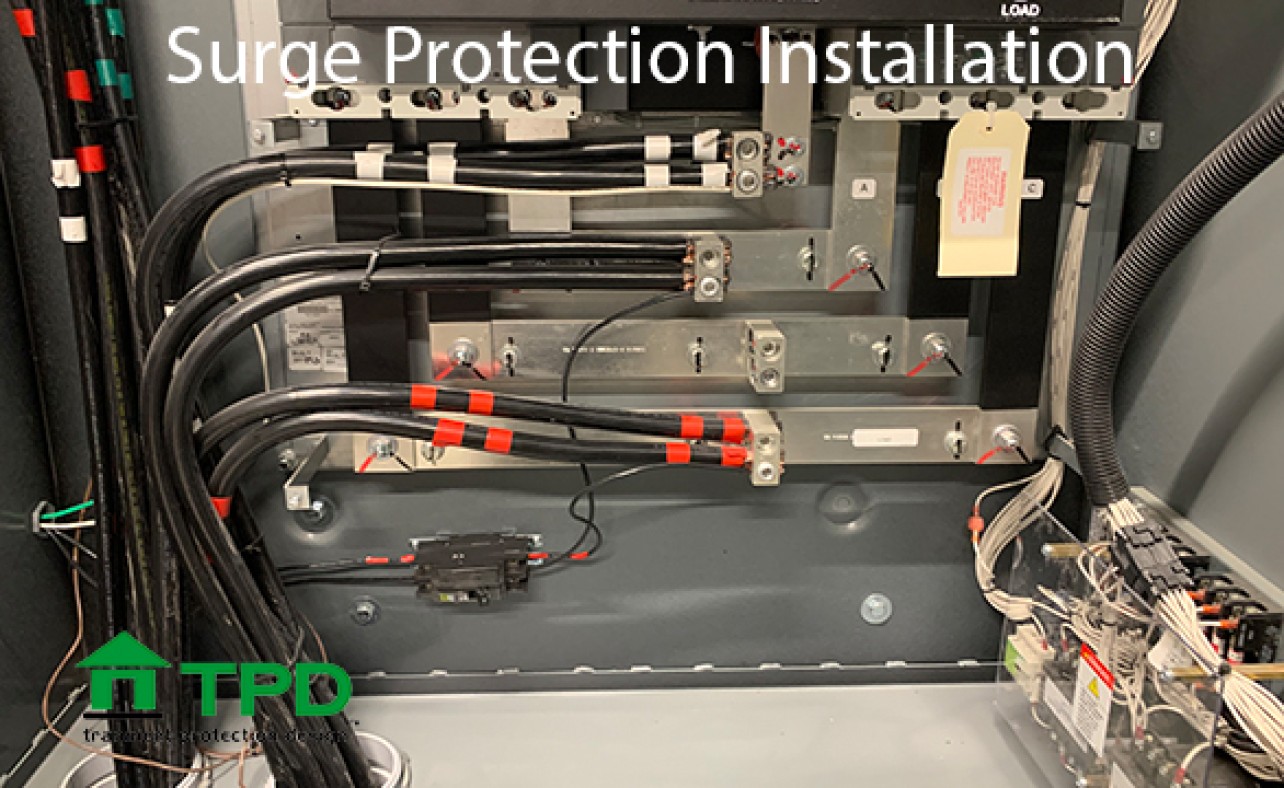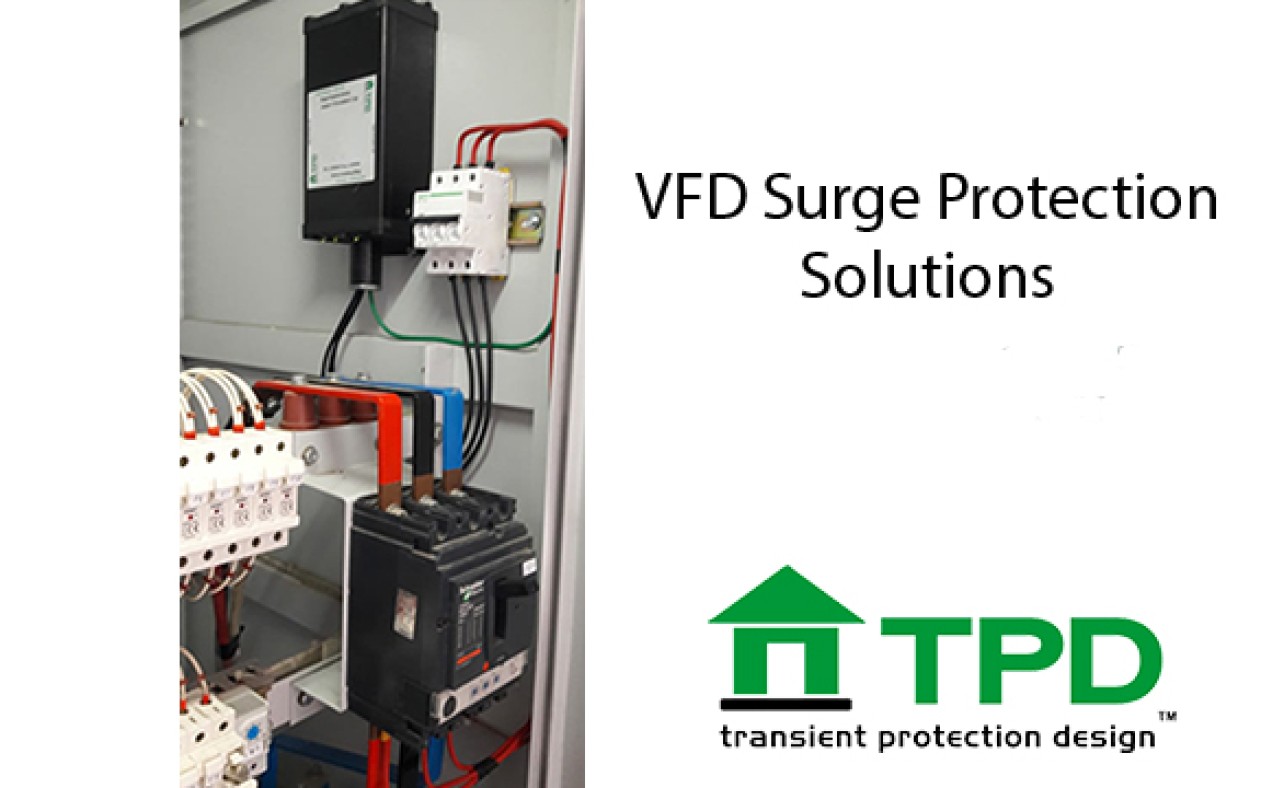VFD Surge Protection and Power Filtering
Transient Protection Design surge protection products are ideal for protection of Variable Frequency Drives (VFDs) manufactured by companies such as ABB, Allen Bradley, General Electric, Hitachi, Mitsubishi, Toshiba, Yaskawa, and Westinghouse. Surge protection for VFDs will improve power quality by surge protecting and power filtering the incoming power to the VFD. TPD surge protection for VFD equipment is essential to protect these valuable assets, avoid costly downtime, maintain process efficiency, prevent data loss, extend equipment lifespan, comply with safety standards, and reduce environmental impact. It's a proactive measure that contributes to the overall reliability, efficiency, and financial stability of industrial operations.
TPX-480NN-F-100 480V No Neutral Panels
TPX-240NN-F-100 240V No Neutral Panels
15 Year Warranty Including Lightning
UL1283 EMI/RFI Filter
UL1449 5th Edition Surge Suppressor
TYPE 1 & Type 2 SPD
Nema 4 Weatherproof Enclosure
100kA Per Phase
100kAIC Short Circuit Current Rating
Can be installed on any amperage panel
How To Surge Protect Variable Frequency Drives
Surge Protect 480 Volt No Neutral VFDs: TPX-480NN-F-100
Surge Protect 240 Volt No Neutral VFDs: TPX-240NN-F-100
Install the TPX-480NN-F surge protector unit at each drive. Or protect multiple drives by installing a VFD surge protector at drive cabinet or motor control center. For additional surge protection, install a small series wired surge protector unit on the circuit feeding the low voltage controls when possible.
Surge Protect All 120 Volt Control Circuits: TPD-LT120-15A
Surge Protect All 24 Volt Control Circuits: TPD-DM24-15A
Why Surge Protect VFDs?
By positioning surge protectors at various points, you can protect all VFD equipment from incoming surges and transients from the utility line, as well as from cross circuit transients caused by the VFDs themselves. These transients, generated when VFDs switch on and off, can damage and degrade other equipment over time. Additionally, surge protectors help mitigate transients from the drives that might impact electronic loads in different areas of the facility. When dealing with harmonics, surge protection is crucial to protect VFD equipment.
TPD manufactures a range of suppressors, allowing for a tailored approach to equipment protection. The three-phase suppressor, for example, can be installed at the drive cabinet, individual drive, soft start, Motor Control Center (MCC), or distribution panel that powers the equipment. This placement ensures protection for all downstream equipment from both external surges and internal transients generated within the facility.
Suppressors installed at or near each drive, or on each drive cabinet or MCC, are essential to counteract internally generated transients. Normal equipment switching within a facility can cause surges that impact other equipment if no suppressor is present on each device connected to a common bus or distribution panel. Moreover, in the event of a lightning strike near the facility, the absence of a surge suppression unit could allow lightning-induced surges to propagate through the overhead bus or distribution panel, affecting multiple circuits. This risk extends to sub-panels feeding external electrical equipment like parking lot lights, signs, security gates, or rooftop HVAC units. Lightning striking these external elements could travel back to the sub-panel and from there to other circuits, or even to the main distribution panel.
Consequently, relying solely on surge suppression at the service entrance is insufficient. It's secondary in priority to installing protection directly at the equipment level, or at the distribution panel, MCC, or drive cabinet that feeds the individual drives and other pieces of equipment. This comprehensive approach ensures maximum protection against a variety of electrical transients and surges.
The Importance of Surge Protecting VFDs
Preserving Equipment Integrity
VFDs are essential components in commercial and industrial settings, controlling the speed and power of electric motors. They contain sensitive electronics, including microprocessors and power electronics. Surge events, such as voltage spikes, power company surges, or lightning strikes, can easily damage these components, leading to costly repairs or replacements. TPD surge protection safeguards the integrity of VFD equipment, ensuring it operates reliably.
Avoiding Costly Downtime
Downtime in industrial processes can result in significant financial losses. When VFD equipment fails due to surges, production grinds to a halt. TPD surge protection helps prevent these failures, ensuring continuous operation and minimizing downtime-related costs.
Maintaining Process Efficiency
VFDs are often used to control critical processes, such as HVAC systems, conveyor belts, and manufacturing lines. Any disruption in VFD operation can impact process efficiency and product quality. TPD surge protection maintains the stability of VFDs, ensuring that processes run smoothly and products meet quality standards. Today, VFDs are also found in residential HVAC systems.
Preventing Data Loss
Some VFDs are equipped with advanced monitoring and control features, and they may store valuable operational data. Surge-induced failures can result in data loss, which can be both costly and detrimental to troubleshooting and performance analysis. TPD surge protection safeguards against data loss by preventing equipment damage.
Extending Equipment Lifespan
VFDs are long-term investments for industrial facilities. Replacing damaged VFDs prematurely can be a substantial financial burden. TPD surge protection helps extend the lifespan of VFD equipment, reducing the frequency of replacements and associated costs.
Compliance and Safety
In certain industries and applications, compliance with safety standards and regulations is mandatory. TPD surge protection can help meet these requirements, ensuring safe and reliable VFD operation and minimizing risks to personnel and equipment.
Environmental Considerations
VFDs are often used to control motors in energy-efficient systems. Equipment failures due to surges can lead to increased energy consumption, which is not only costly but also less environmentally friendly. TPD surge protection helps maintain energy-efficient operations and sustainability goals required for LEED certification.
Financial Costs and Life Cycle Savings
The cost and repair of a single surge event or two at most will typically pay for the price a TPD VFD surge protector. Although labor costs vary, having a specialized technical person show up with parts and pay for travel will have a minimum charge of $500 to $1500 on average. This means, for a small upfront investment, our surge suppressor products will lead to enormous life cycle savings!
Surge Suppression for VFDs
VFDs are very common in industry and can provide many years of reliable service. Unfortunately, one of the major causes of VFD failure are electrical surges. From no detectable effect to complete destruction, the effects on equipment can be many. Fortunately, there are surge protection devices (SPDs) on the market that can provide protection for your VFDs. By definition, an electrical surge is a transient electrical voltage or current that occurs in an electrical circuit. Typically, a power surge is an oversupply of electrical voltage from a variety of sources. Sometimes these surges come from the electrical utility, due to switching or equipment failure. Other times, they come from an internal surge from equipment inside the facility. Sometimes, the problem is a lightning strike. What kind of damage can a surge do to your VFD? In a word, catastrophic. The front end of a typical drive consists of a semiconductor diode bank. These diodes convert the AC line voltage to a DC voltage and severe overvoltage will destroy these devices. Recently, a massive electrical storm in Illinois destroyed multiple drives in a manufacturing facility. While the cost to replace these drives was a somewhat reasonable figure, the subsequent downtime ran into the hundreds of thousands of dollars. (Written by Jim Davis, Automation Engineer)
PDF – VFD – Nursery Case Study. ROI met in only a few months.
PDF – VFD – Reduced troubleshooting time & lost production. 40% reduction in electrical maintenance.




